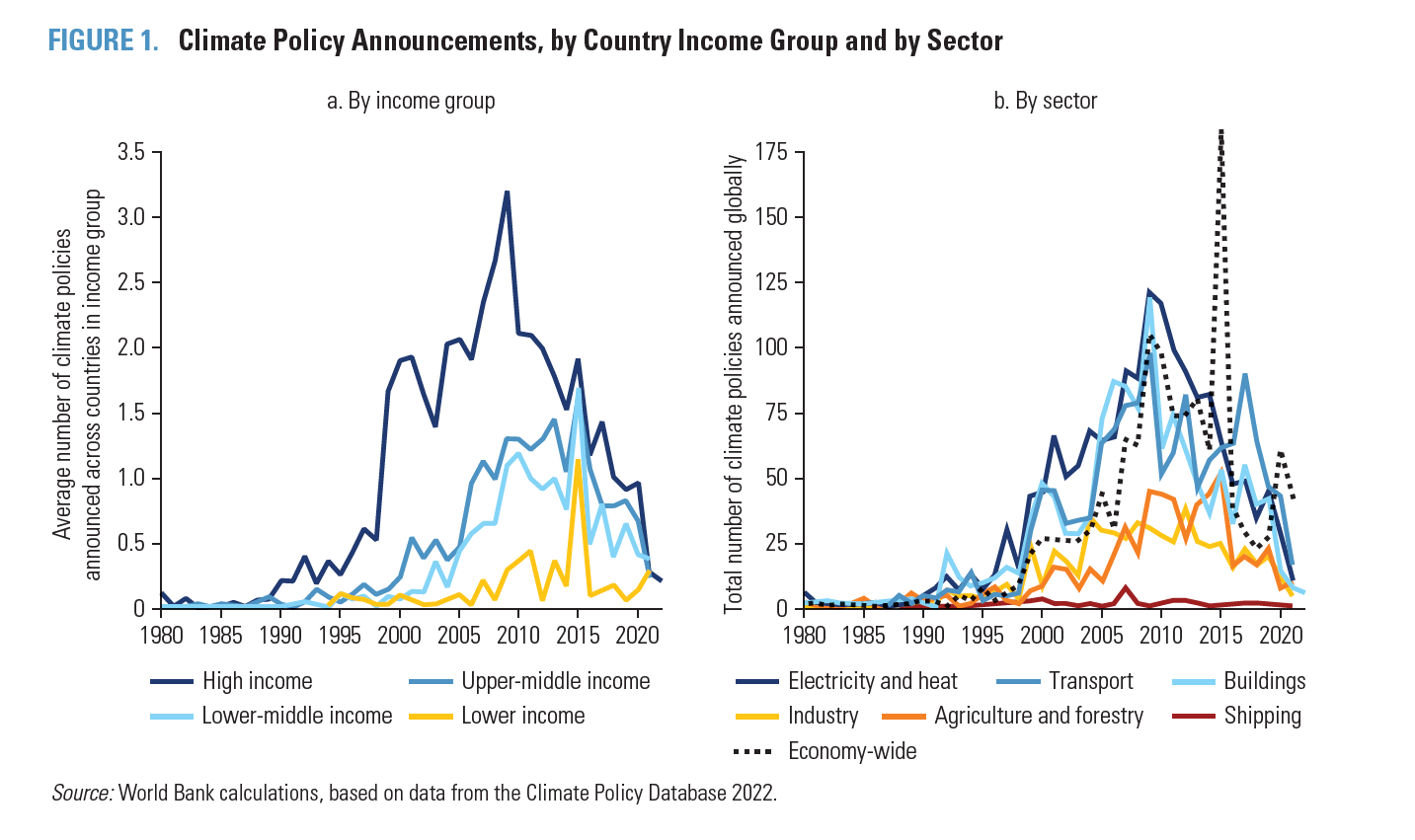 Aerial view of rooftop solar panels in buildings in India.
Aerial view of rooftop solar panels in buildings in India.
Extreme weather events in 2022 and 2023 broke multiple records as storms, heatwaves, floods, and droughts brought life-changing devastation to millions of people. A third of Pakistan was flooded; Europe experienced its hottest summer in 500 years; and the Horn of Africa suffered its worst drought in over 40 years.
Set against rising temperatures, the climate challenge is no longer about high-level commitments; it must be about action on the ground. While countries’ climate pledges have been increasingly aligned with long-term global objectives, the policies needed to meet these commitments have too often been absent or ineffective. It’s urgent now to implement transformative climate policies and close the gap between ambition and reality.
On this front, there is some good news: Governments in all regions and at all income levels are active and are introducing increasingly ambitious climate policies covering all sectors.
Our new World Bank report -- Reality Check: Lessons from 25 Case Studies Advancing a Low-Carbon Future -- highlights effective climate policies. Using the New Climate Institute’s Climate Policy Database and 25 in-depth case studies, the report presents a dynamic picture of global climate policy trends over the past three decades and fills a critical gap in climate research by documenting successful implementation of climate policies.
Countries have introduced a vast number of climate policies across all sectors and geographies – more than 4,500 over the last three decades. In the early 2000s, most climate policies were announced by the richest countries. More recently, there has since been a rapid increase in climate policy announcements by lower-income countries, with some of the more populous countries—such as China, India, and Indonesia—introducing a comparably large number of climate policies.

Policies on energy efficiency, renewable energy, and greenhouse gas reductions are increasing
A country-by-country analysis shows that sectoral policies are often the first to be implemented, but they are gradually being supplemented by economy-wide approaches. Although policy announcements have declined in recent years, cross-cutting policies on energy efficiency, renewable energy, and greenhouse gas reductions have been steadily increasing.
Let’s take a look at what this means in practice.
Over the past decade, India purposefully transformed its energy sector and has become the world’s fifth largest solar market and a champion of solar power. Its choice of carrots and sticks – including state-level renewable energy purchase obligations, incentives, innovative financing and more – provides a roadmap for other emerging market countries determined to grow while making the leap to clean energy.
In the agricultural heartland of China’s Guangdong province, successfully increasing agricultural production came at the cost of significant environmental degradation. Thanks to a series of interventions in the agriculture sector, today Guangdong has dramatically mitigated GHG emissions, reduced water pollution, increased crop yields and reduced costs to farmers.
In the aftermath of the Arab Spring, Egypt embarked on an ambitious effort to reform energy subsidies as part of a broader effort to boost growth and macroeconomic stability. As a result of carefully designed reforms, the country significantly reduced the fiscal burden of energy subsidies and improved energy sector viability, consumer welfare and economic productivity. The reforms helped attract significant private investment in cleaner alternatives.
Climate policies always involve compromise
Many of the examples are not necessarily first-best policies or even best practice: to achieve successful implementation, governments often had to compromise. They faced institutional capacity constraints and had to manage trade-offs with other policy objectives. Some interventions were just the first step and most countries are adjusting policy design as they draw lessons from real-world implementation.
The report offers insights into how policies play out in countries with different income levels and political contexts. It also sheds light on how countries can design and implement climate policies and the compromises required. The analysis reveals the critical importance of political and public buy-in, along with strong public institutions, cross-party support, and ongoing public engagement.
The report also highlights an important gap in credible ex post analysis of the impacts of low-carbon policy implementation. To learn from each other, countries need to improve monitoring of implementation and emissions outcomes, but also to monitor and report costs, distributional impacts and other benefits.
The World Bank is sharing these case studies to inspire countries to learn from others and to inform current and future climate policy. The insights and lessons in this report are not the final word. As with all policy processes, the learning journey for climate policies is never complete; rather, it continues to evolve and adapt in light of new approaches, technologies, and climate challenges.
The climate crisis presents an urgent challenge for humanity, but also opens up enormous opportunities. Now is the time to come together and redouble our efforts to create an equitable low-carbon future.
Related:
- Download the report: Reality Check: Lessons from 25 Case Studies Advancing a Low-Carbon Future
- Feature Story: Climate Policies with Real-World Results
- Website: World Bank - Climate Change



Join the Conversation